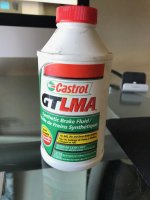AUSMHLY
Yoda
Offline
I noticed a leak, below the right wheel tire. Took off the drum, the wheel cylinder is leaking.
Brake/clutch reservoir is low.
Why do the wheel cylinders start leaking? When replacing it, should the other side be replaced at the same time, or only after it starts leaking. These can go years without a problem, right?
The brake pads have some oil on them, seem thick enough to last a while longer. OK to clean them with brake cleaner and keep them?
Local parts store doesn't sells these wheel cylinders. Moss sells two models. What's your thought on $15.99 vs $59.99.
Do I need the brake assembly rubber grease? If so, where do I put it?
Moss only sells Dot 4 Castrol brake fluid. Thought BJ8 should be Dot 3?
I have always had a mechanic work on my brakes, this time I thought I'd give it a try
021-151 BN7-BJ8 Wheel cylinder, 3/4” bore, Rear, aftermarket $15.99
021-161 BN7-BJ8 Wheel cylinder, 3/4” bore, Rear, TRW brand $59.99
220-443 Brake Assembly rubber Grease $2.59
What fluid, Castrol brake fluid DOT 3 or DOT 4
Brake/clutch reservoir is low.
Why do the wheel cylinders start leaking? When replacing it, should the other side be replaced at the same time, or only after it starts leaking. These can go years without a problem, right?
The brake pads have some oil on them, seem thick enough to last a while longer. OK to clean them with brake cleaner and keep them?
Local parts store doesn't sells these wheel cylinders. Moss sells two models. What's your thought on $15.99 vs $59.99.
Do I need the brake assembly rubber grease? If so, where do I put it?
Moss only sells Dot 4 Castrol brake fluid. Thought BJ8 should be Dot 3?
I have always had a mechanic work on my brakes, this time I thought I'd give it a try
021-151 BN7-BJ8 Wheel cylinder, 3/4” bore, Rear, aftermarket $15.99
021-161 BN7-BJ8 Wheel cylinder, 3/4” bore, Rear, TRW brand $59.99
220-443 Brake Assembly rubber Grease $2.59
What fluid, Castrol brake fluid DOT 3 or DOT 4

 Hi Guest!
Hi Guest!

 smilie in place of the real @
smilie in place of the real @
 Pretty Please - add it to our Events forum(s) and add to the calendar! >>
Pretty Please - add it to our Events forum(s) and add to the calendar! >> 



